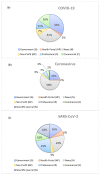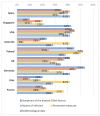Online Information of COVID-19: Visibility and Characterization of Highest Positioned Websites by Google between March and April 2020-A Cross-Country Analysis
- PMID: 35162513
- PMCID: PMC8835343
- DOI: 10.3390/ijerph19031491
Online Information of COVID-19: Visibility and Characterization of Highest Positioned Websites by Google between March and April 2020-A Cross-Country Analysis
Abstract
Background: The WHO has used the term "infodemic" to describe the vast amount of false and true information that was making it difficult for people to find reliable information when they needed it. The infodemic spreads faster than COVID-19 itself. The main objective of the study was to characterize and analyze content about COVID-19 returned by Google during the pandemic and compare it between countries.
Methods: The study was conducted between 30 March and 27 April 2020. The information was searched through local Google websites using the "COVID-19", "Coronavirus", "SARS-CoV-2" and "fake news" keywords. The search was conducted in Australia, France, Germany, Italy, Poland, Singapore, Spain, UK and the USA. The total number of the analyzed webpages was 685.
Results: The most frequent types were News websites 47% (324/685) and Governmental 19% (131/685) while the least were Health portals 2% (17/685) and Scientific journals 5% (35/635), p < 0.001. United States and Australia had the highest share of Governmental websites. There was a positive correlation between the amount of preventive information and a number of SARS-CoV-2 infections in countries. The higher the number of tests performed, the higher was the amount of information about prevention available online.
Conclusions: Online information is usually available on news and government websites and refers to prevention. There were differences between countries in types of information available online. The highest positioned (the first 20) websites for COVID-19, Coronavirus and SARS-CoV-2 keywords returned by Google include true information.
Keywords: COVID-19; Coronavirus; Google; Internet; SARS-CoV-2; fake news; infodemic; infodemiology; misinformation; online information.
Conflict of interest statement
The authors declare no conflict of interest.
Figures






Similar articles
-
COVID-19-Related Web Search Behaviors and Infodemic Attitudes in Italy: Infodemiological Study.JMIR Public Health Surveill. 2020 May 5;6(2):e19374. doi: 10.2196/19374. JMIR Public Health Surveill. 2020. PMID: 32338613 Free PMC article.
-
Global Infodemiology of COVID-19: Analysis of Google Web Searches and Instagram Hashtags.J Med Internet Res. 2020 Aug 25;22(8):e20673. doi: 10.2196/20673. J Med Internet Res. 2020. PMID: 32748790 Free PMC article.
-
Understanding Health Communication Through Google Trends and News Coverage for COVID-19: Multinational Study in Eight Countries.JMIR Public Health Surveill. 2021 Dec 21;7(12):e26644. doi: 10.2196/26644. JMIR Public Health Surveill. 2021. PMID: 34591781 Free PMC article.
-
COVID-19 prevention and treatment information on the internet: a systematic analysis and quality assessment.BMJ Open. 2020 Sep 10;10(9):e040487. doi: 10.1136/bmjopen-2020-040487. BMJ Open. 2020. PMID: 32912996 Free PMC article.
-
Characteristics, Influence, Prevention, and Control Measures of the Mpox Infodemic: Scoping Review of Infodemiology Studies.J Med Internet Res. 2024 Aug 30;26:e54874. doi: 10.2196/54874. J Med Internet Res. 2024. PMID: 39213025 Free PMC article.
Cited by
-
The Relationship between Searches for COVID-19 Vaccines and Dynamics of Vaccinated People in Poland: An Infodemiological Study.Int J Environ Res Public Health. 2022 Oct 14;19(20):13275. doi: 10.3390/ijerph192013275. Int J Environ Res Public Health. 2022. PMID: 36293855 Free PMC article.
-
Evaluating the readability, quality and reliability of online patient education materials on post-covid pain.PeerJ. 2022 Jul 20;10:e13686. doi: 10.7717/peerj.13686. eCollection 2022. PeerJ. 2022. PMID: 35880220 Free PMC article.
-
Disparities in COVID-19 Information Sources and Knowledge in South Korea.Int J Environ Res Public Health. 2022 Apr 25;19(9):5198. doi: 10.3390/ijerph19095198. Int J Environ Res Public Health. 2022. PMID: 35564592 Free PMC article.
-
Online information on chronic pain in 3 countries: an assessment of readability, credibility, and accuracy.Pain Rep. 2023 Jun 16;8(4):e1078. doi: 10.1097/PR9.0000000000001078. eCollection 2023 Jul-Aug. Pain Rep. 2023. PMID: 37342519 Free PMC article.
-
COVID-19 Misinformation and Social Network Crowdfunding: Cross-sectional Study of Alternative Treatments and Antivaccine Mandates.J Med Internet Res. 2022 Jul 27;24(7):e38395. doi: 10.2196/38395. J Med Internet Res. 2022. PMID: 35820053 Free PMC article.
References
MeSH terms
LinkOut - more resources
Full Text Sources
Medical
Miscellaneous

